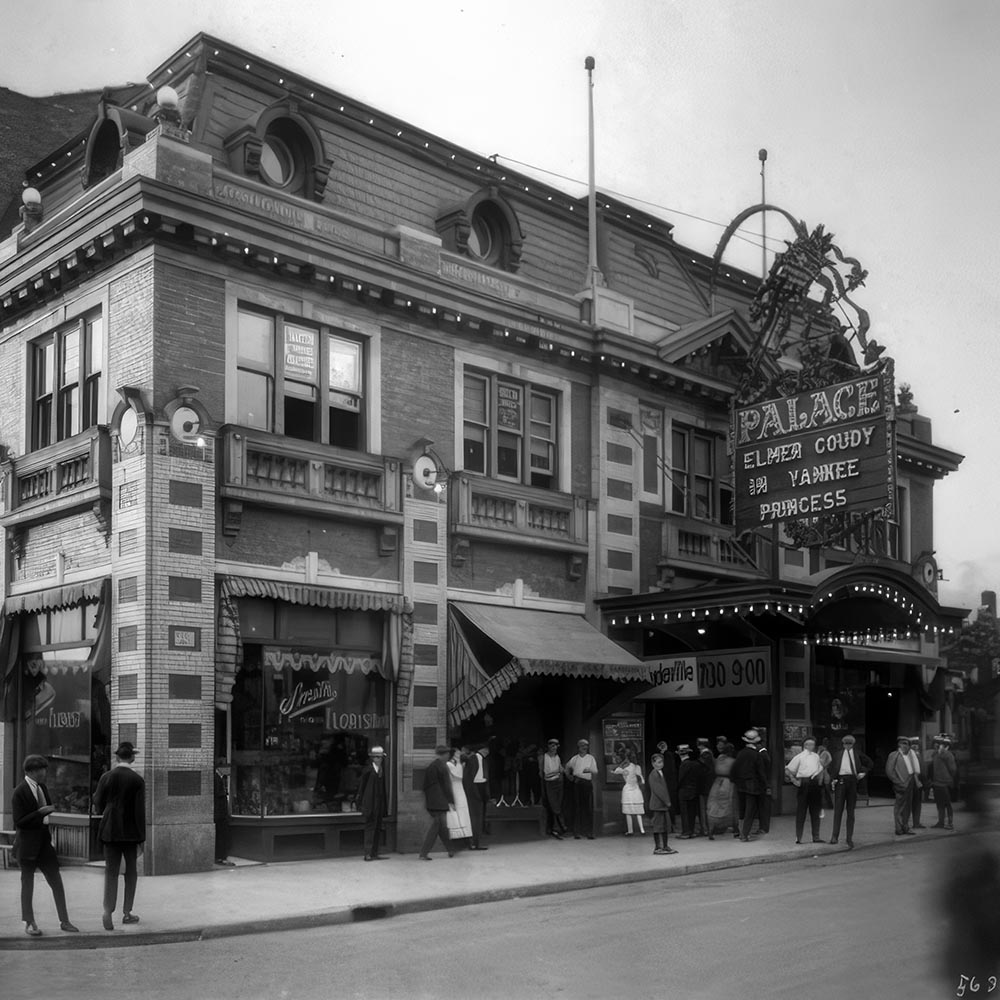
<< Go Back up to Atmospheric Theatres Main Page


The Palace Theatre was built for the Butterfield Theaters chain, under the control of Walter S. Butterfield. It opened at the end of August 1917 with a presentation of high-class vaudeville: a mix of musical arrangements by the theatre’s six-piece orchestra, and vaudeville acts headlined by Long Tack Sam & Company, a Chinese juggler, magic, contortionist and acrobatic act.
The theatre was designed by architect John Eberson and built under his direction by general contractor Henry L. Vanderhorst of Kalamazoo, Michigan. The interior decoration was noted as being quite novel prior to the theatre’s opening. The general motif was that of a Roman Garden, bounded by ancient stone walls and a pergola of beams above, all under a Roman sky. Byzantine colors were used to present mosaic patterns to “relieve the color scheme offered by this exterior treatment”.
General research has found that architect John Eberson designed three Proto-Atmospheric theatres (the Majestic Theatre in Dallas, Texas; the Indiana Theatre in Terre Haute, Indiana; and the Orpheum Theatre in Wichita, Kansas) prior to his self-proclamation of the new Atmospheric theatre style embodied in the Majestic Theatre in Houston, Texas. The discovery, in May 2025, that Eberson had designed “an outdoor theatre inside” five years before starting to think about the Atmospheric theatre style, is quite a revelation.
The Flint Journal of 31st August 1917, reporting on the theatre’s opening the night prior, went further and described the auditorium as: “The new Palace theater is a thing of beauty of which the owners, The Palace Theater company, may well be proud. The interior is fashioned to represent a Roman garden with its grey stone walls and above, the dome is fashioned with pergola beams above which is an Italian sky with stars twinkling here and there and shades of varied colors such as one might see in the early evening, the effect of the pink tints of the setting sun mingling with the dark blue of the first of the night. All these lighting effects are produced by lamps hidden by the indirect lighting system. On the side and rear walls of the auditorium are lamps of old green bronze fashioned to represent the famed lamp of Aladdin”.
It was further reported that the “dead effect” of the stone side walls was heightened by bright Byzantine colors frescoed beneath the balcony, in the soffits of the ceiling beams, and the crowning borders of the side walls.
On Monday 2nd December 1918 there was a fire at the theatre. As reported  by The Flint Journal, repairs were quickly effected, including with the involvement of John Eberson, and the theatre reopened on 22nd December 1918.
by The Flint Journal, repairs were quickly effected, including with the involvement of John Eberson, and the theatre reopened on 22nd December 1918.
At the time of writing (mid-2025) interior photos of the auditorium have yet to come to light, and the interior was completely remodeled in 1950 before being demolished in 1977. However, it very much sounds like this was John Eberson’s first foray into what he would later proclaim in January 1923 as the Atmospheric theatre style. The Palace opened in August 1917, nearly four years before Eberson’s first proto-Atmospheric theatre (the Majestic Theatre in Dallas, Texas) and a full five and a half years ahead of his first self-proclaimed Atmospheric theatre, the Majestic Theatre in Houston, Texas.
In mid-May 1950, M.F. Gowthorpe, president of W.S. Butterfield Theaters Inc., announced plans for the complete interior and exterior remodeling and modernization of the theatre. Plans were drawn-up by noted theatre architect C. Howard Crane in association with architects Emler Keihler and Dixon Kellogg. The remodeled theatre reopened in early September 1950.
The deed for the theatre was given to the University of Michigan in May 1976, and the theatre closed. There was debate about the theatre’s future, however demolition commenced on 11th February 1977 and was completed within about one month, to make way for a new downtown campus for the University of Michigan-Flint  .
.
 Further Reading
Further Reading .
. by Gary Flinn, published by The History Press. ISBN 9781625858412.
by Gary Flinn, published by The History Press. ISBN 9781625858412.Photographs copyright © 2002-2025 Mike Hume / Historic Theatre Photos unless otherwise noted.
Text copyright © 2017-2025 Mike Hume / Historic Theatre Photos.
For photograph licensing and/or re-use contact us here  . See our Sharing Guidelines here
. See our Sharing Guidelines here  .
.
| Follow Mike Hume’s Historic Theatre Photography: |  |
 |